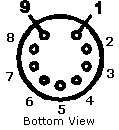| Vacuum Tube Pin Numbering |
| A couple beginning vacuum tube experimenters have asked, "How are the pins on vacuum tubes numbered?" Here is a simple explanation that is applicable to most base styles |
|
Most tube (valve) bases have some sort of key (as in the case of octal and loktal types)
or other indication (such as a gap, as in the case of 7-pin and 9-pin miniatures) of
orientation.
Looking at the tube (or socket) from the bottom, place the orienting indication (key or gap) at the top. The first pin to the right of this orienting indicator is Pin 1. The remaining pins are numbered in a clockwise direction from pin 1. An example is the common 9-pin miniature base (as 12AX7, 12AU7, etc.) shown below: |

|
|
7-pin miniatures work the same, except of course that the last pin will be pin 7. Same
goes for compactrons (9- and 12-pin) and MagNoval (9-pin) types.
Octal (6L6 etc.) and Loktal (many 7xx and 14xx types) The key in the center points to the space between pin 1 and pin 8. 4-pin (e.g. 80) and 6-pin (e.g 1625) Imagine the "key" to be between the two thicker pins. 5-pin (e.g. 807) Imagine the key to be opposite to the pin that's off to itself. This means that this "solitary" pin is actually pin 3. Acorn tubes, nuvistors, transmitting tubes, and other oddballs: Consult the manual for pin designation. For more info (including pictures) of various tube bases, consult this Tube sockets site. |
Back to Fred's Vacuum